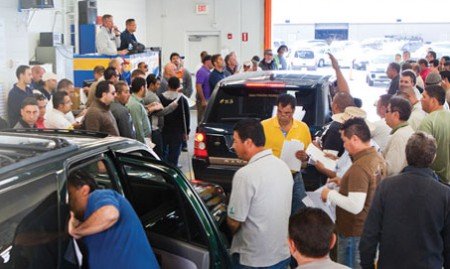CarMax Explains Why Wholesale Unit Sales Soared

Carmax saw wholesale vehicles rise by almost 10 percent in Q1 of its 2015 fiscal year.
When CarMax announced results from a successful first quarter of its 2015 fiscal year — notching record quarterly sales and earnings — company management focused on one used metric, in particular: wholesale unit sales.
While total used retail sales rose by 9.8 percent in Q1, wholesale unit sales were up slightly higher, experiencing a 9.9-percent spike.
The company sold 97,098 wholesale vehicles this past quarter.
The growth on the wholesale side of the business was due in part to increased appraisal traffic and a stronger wholesale vehicle buy rate, as well as the addition of new stores, the company said.
During the first quarter, the used-car giant opened four stores, including three stores in new markets (Rochester, N.Y.; Dothan, Ala.; and Spokane, Wash.) and one in an existing market (Harrisburg/Lancaster, Pa.).
Much of the company’s conference call to discuss Q1 financial results focused around their wholesale success, as investors questioned company management on what factors led to the rise in sales.
Tom Folliard, president and chief executive officer of Carmax, told listeners that management was a bit surprised both wholesale and retail sales rose in a similar fashion this past quarter, as the two metrics rarely follow the same trends.
“I’m glad I’m finally right in that I believe over time wholesale and retail will grow at a similar pace. In the past, they (wholesale and retail) seem to almost never be connected in a quarter … there is a lot of volatility in that business, but I still believe overtime that retail and wholesale will grow similarly over a long period of time.," Folliard said. "This quarter we happened to match up."
The company not only sold more wholesale vehicles, but they also made more profit on these units, as auction prices spiked high during tax season.
The average selling price for a CarMax wholesale vehicle in Q1 was $5,450, up 1.2 percent from the same period of the 2014 fiscal year.
“Well, in the spring, if this was what we would say a normal year, we would see some appreciation in the spring and then kind of a steady decline throughout the rest of the year,” said Folliard, commenting on the high wholesale prices this spring. “And this year, we saw more appreciation in the spring than we are used to. And lots of people attributed this to weather and pent-up demand for inventory. So we will go with that.”
And finally, dealers and buyers who struggled through a time of very tight used supply in the years following the 2008 economic downturn are finally seeing quality, used supply at auction expand.
Folliard said off-lease vehicles are beginning to feed the lanes in higher quantities, but he also pointed out another trend leading to growing wholesale supply at his company: trade-ins.
“It (supply expansion) is largely driven by consumer behavior, not just people who lease cars, but people who buy cars, and how quickly do they then trade those cars in," he explained.
And Folliard said the number of customers handing in the keys to their old rides is growing.
And this ties directly into an issue many conference call listeners asked about last week: the relationship between retail sales and wholesale unit sales.
Folliard suggested listeners take a look at the variables behind wholesale volume growth, such as “how many customers show up at the store? Of those customers, how many get their car appraised? Of the ones who get their car appraised, how many sell the car?
“There is always movement in some of those variables. We had a strong buyer rate, a little over 30 percent, slightly up compared to the year prior, and with total sales being up 10 percent and that being driven by foot traffic,” said Folliard. “It’s (wholesale to retail sales ratio) came out the way you think it would would come out.”
But Folliard stressed often over the course of the call: “But as I said, it’s just on a quarter by quarter basis, these two things are never exactly connected.”

 View The Latest Edition
View The Latest Edition

